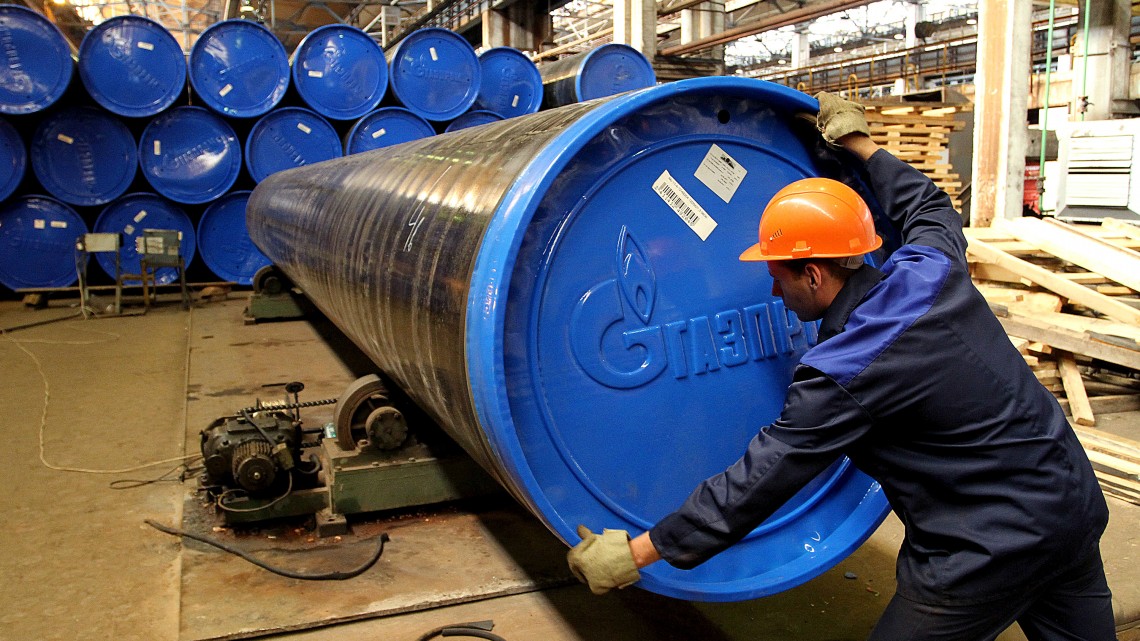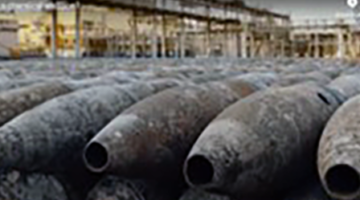Photo credit © Gazprom
China’s ravenous demand for energy and Russia’s huge supply of nearby oil and gas are clearly complementary, but until very recently large Sino-Russian energy agreements proved elusive. Now their recent mega-gas deal, which follows several important oil deals, suggests that Beijing and Moscow are finally on the road to consummating this relationship.
Exporting energy is the primary driver of the Russian economy and main source of the Kremlin’s revenue and international influence. The Russian Federation has the world’s largest natural gas reserves. Although its natural gas production rates have remained relatively stable if enormous over the course of the last decade, Russia under Vladimir Putin has steadily enhanced and expanded its oil production over that same period. Russia has become the world’s second largest oil producer, after Saudi Arabia.
Chinese policy makers have become more interested over time in acquiring Russia’s oil and gas. China is the world’s largest energy consumer and has recently become the largest net importer of oil. Natural gas covers only 4 percent of China’s total energy consumption, but the government desires to raise this level significantly to help reduce domestic pollution and China’s contribution to global climate change.
The gap between China’s domestic hydrocarbon production and its fast-growing consumption is widening. Domestic resources will not meet China’s growing demand for energy in general, and for oil and natural gas in particular. Although the government has tried to improve energy conservation and expand the use of nuclear and renewable energy sources, the PRC will still need to import enormous quantities of oil and increasingly gas for the foreseeable future.
Using oil and gas helps China burn less coal, currently the country’s main domestic energy source but also a major source of air pollution and carbon emissions. Although coal will likely remain China’s dominant energy source for years, the Chinese demand for oil is expected to continue to grow faster than domestic crude production. As a result, China could import as much as 75 percent of its crude oil by 2035.
China will also import more natural gas over time since its consumption, which is being promoted by the government, is expected to rise from 170 billion cubic meters (bcm) in 2013 to 420 bcm in 2020 and then grow by more than 14 percent annually through 2030. The China National Petroleum Corporation (CNPC) expects gas consumption for 2014 to amount to 186 bcm, a 11 percent increase over 2013, with imports rising 19 percent over the previous year. China already imports more than 40 percent of its natural gas.
In addition, the government is trying to diversify foreign energy sources to limit China’s dependence on any single exporting country or region. For China, Russian oil and gas is an additional source of energy that, due to its geographic proximately, is cheaper to import. Russia’s overland transportation networks are also more secure compared with the more expensive and vulnerable maritime shipments of hydrocarbons that reach China from Africa, Australia, and the Persian Gulf.
The idea of sending Russian oil and gas to China by pipeline was first mooted in the 1990s. Chinese and Russian energy managers have been actively negotiating possible deals since the mid-2000s. During Putin’s March 2006 trip to Beijing, Gazprom and the CNPC signed a memorandum of understanding about constructing a 6,700-kilometer gas pipeline that would link western Siberia to China’s Xinjiang Province by bisecting Russia’s Altai Republic. At the June 2009 St. Petersburg International Economic Forum, Kremlin energy czar Igor Sechin said that Russia was prepared to sell China as much natural gas as it required.
Despite these mutual incentives to increase bilateral energy cooperation, Chinese-Russian energy cooperation has until recently been surprisingly limited. The two sides repeatedly announced grandiose oil and natural gas deals that, again until recently, failed to materialize. Many of their declared agreements were simply framework accords, memoranda of understanding, or declarations of intent to cooperate on concrete projects at a later date.
The initial reason for the small volume of Russian oil and gas sold to China was the underdeveloped transportation infrastructure connecting the two countries. During most of the Cold War, the border between China and the various Soviet republics was sealed and heavily militarized. In addition, the Soviet energy pipeline network flowed from east to west since Europeans were the main foreign purchasers of the gas produced in the Soviet republics of Russia, Azerbaijan, and Central Asia. It has only been in the last decade that Russian energy planners have, joining the newly independent countries of Central Asia, made a comprehensive effort to send gas and oil eastward toward the expanding markets of East Asia.
For the first decade of their new post-Cold War relationship, most Russian crude oil could only reach China via costly and limited capacity rail lines to the Chinese cities of Harbin and Daqing as well as through Mongolia. At the Zabaikalsk-Manzhouli border oil terminal, the rail cars had to be offloaded and reloaded on trucks due to the different rail track gauges used by Russia and China.
Under Putin, the Russian government also limited Chinese as well as other foreign ownership of its major Russian energy assets, using such techniques as rewriting production sharing agreements or otherwise squeezing foreign companies out of important projects over time, even though this tactic often resulted in the projects’ losing foreign expertise and capital. In 2002, the Russian parliament blocked CNPC from acquiring a majority stake in Slavneft, a major Russian oil producer, even though CNPC’s bid was almost twice as high as that of the eventual Russian winner. Russia also declined a Chinese-South Korean bid to help develop the Kovytka Pipeline designed to link the Irktusk gas field to East Asia, favoring Gazprom instead. In June 2006, the Russian authorities did allow Sinopec to buy a stake in oil-producer Udmurtneft, but only on the condition that it resold sufficient shares to give Russia’s state-owned Rosneft a majority stake in the enterprise.
Until a few years ago, the Chinese and Russian governments engaged in contentious negotiations over which pipelines to build, where to locate them, the schedule for their construction, and who would pay to build and maintain them. Beijing has long wanted Moscow to devote resources into constructing immovable pipelines to China as proof of Russia’s commitment to a long-term energy supply relationship. Russians understood that their ability to attract capital and concessions on various issues from other countries would decline if they committed to pipelines supplying only the Chinese market. The repeated delays on the Russian side to conduct “feasibility” studies and “environmental” assessments deepened Chinese suspicions that their Russian interlocutors were trying to leverage the potential energy sales to Beijing to enhance Moscow’s negotiating leverage with Japan and Europe.
Meanwhile, Chinese negotiators had achieved significant success in securing oil and gas agreements with neighboring Central Asian governments, circumventing Moscow’s dominant energy position in this former Soviet region by outbidding Russian representatives. In particular, they built a massive Central Asian Gas Pipeline to convey natural gas more than 1,100 miles from Turkmenistan across Uzbekistan and Kazakhstan into China. Turkmenistan alone will supply China with 40 bcm for at least 30 years. Even if the recent Sino-Russian gas deal is fully implemented, Turkmenistan will remain China’s main source of foreign natural gas.
The growth of new Asian energy sources such as LNG, shale oil, and gas fracking have further complicated Sino-Russian energy negotiations since the Chinese could envisage acquiring alternative energy supplies at prices lower than Gazprom was demanding while Russian negotiators had to estimate when these sources might become available to China, and in what quantity, in order to reach an agreement before then.
But in recent years Russia and China appear to have overcome these obstacles. On May 21, the China National Petroleum Corporation and Russian energy giant Gazprom finally signed a $400 billion deal that will have as much as 38 bcm of Russian gas follow to China each year ofr 30 years starting in 2018. This mega-gas deal builds on earlier massive oil sales agreements, especially the 2009 and 2013 contracts between China and Rosneft, Russia’s main oil-exporting company. All these deals follow the “win-win” formula by which China loans Russian firms the money, often as large advanced payments, they need to develop new energy supplies and transport them to China. Russian leaders, in turn, guarantee energy deliveries to China through long-term contracts and the construction of immovable pipelines.
The Arctic is emerging as another area for China-Russia energy cooperation. Russia has relaxed its concerns about China’s efforts to acquire a presence in Arctic energy development since Beijing shifted its earlier stance that all countries, regardless of their geographic or historical connections with the Arctic, should have equal access to Arctic riches. Chinese officials have abandoned their call to treat the Arctic as a global commons available to all. They now publicly accept the existing Arctic regime, based on the Arctic Council, which privileges Russia and other countries with deeper Arctic ties.
Russian officials have allowed the CNC to obtain the right to join Rosneft in exploring three offshore Arctic territories thought to have hydrocarbon deposits. Last year, the Russian government also permitted CNPC purchase a 20 percent stake in Novatek’s Yamal LNG project, marking the first time a PRC firm will have significant ownership in a Russian gas export venture.
The Yamal project costs $20 billion and involves creating LNG from gas fields north of the Arctic Circle. The deal also specifies that CNPC will purchase three million tons of LNG annually for 15 years, beginning with the first exports from the project in 2016.
Russia’s civilian nuclear industry aims to expand its presence in the PRC’s growing nuclear market by selling additional Russian reactors and other nuclear technologies and services. Besides the financial rewards from China’s growing market, winning more on-going and future Chinese tenders would showcase Russia’s technological prowess outside the defense sector and help convince other countries to buy Russia’s civil nuclear products.
The Russian government is seeking to expand use of nuclear power in Russia, and needs orders from China and other countries to help defray the costs of researching and developing new nuclear power technologies and modernizing its nuclear energy sector.
Given the hydropower potential of the rivers in the Russian Far East, as well as China’s intent to significantly expand its use of nuclear power, Russian energy companies would like to export much more hydro power to China. Since March 2009, China has resumed importing electricity generated by Russian dams and other power plants located near the Sino-Russian border. There are even reports that China will pursue alternative energy projects in the Crimea despite Russia’s illegal annexation of the territory.
Thanks to all these deals, energy has become a core pillar of the bilateral relationship between China and Russia, along with their renewed arms trade, their joint diplomatic relations, and their shared management of Central Asia.
Dr. Weitz would like to thank the following interns at Hudson Institute who have helped with this article : Samuel Chow, Logan Nagel, Dylan Royce, Daniel Urchich, and Melanie Weeks
Credit Photo: An employee secures a protective cap to a steel pipe destined for OAO Gazprom, produced by OAO TMK at the company’s plant in Volzhsky, near Volgograd, Russia, on Thursday, Sept. 22, 2011. Russia’s largest producer of steel pipes for the oil and gas industry, isn’t planning a secondary offering this year, its billionaire owner Dmitry Pumpyansky said. Photographer: Andrey Rudakov/Bloomberg.
Richard Weitz is a Senior Fellow and Director of the Center for Political-Military Analysis at Hudson Institute. His current research includes regional security developments relating to Europe, Eurasia, and East Asia as well as U.S. foreign, defense, homeland security, and WMD nonproliferation policies.
Dr. Weitz also is a non-resident Senior Fellow at the Project on National Security Reform (PNSR), where he overseas case study research, and a non-resident Senior Fellow at the Center for a New American Security (CNAS), where he contributes to various defense projects.












